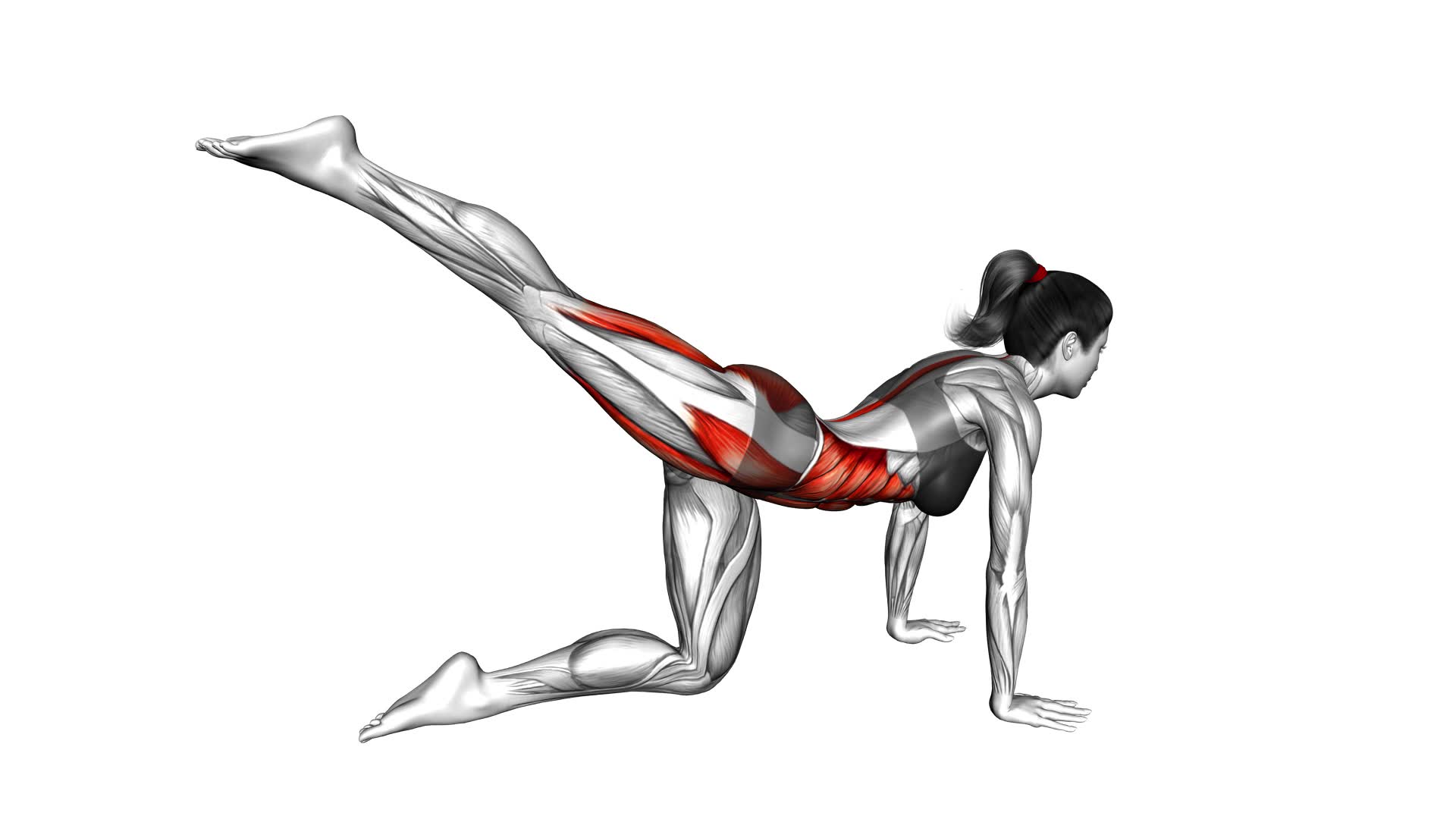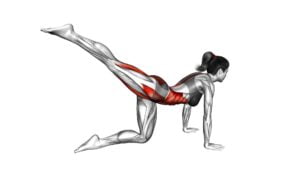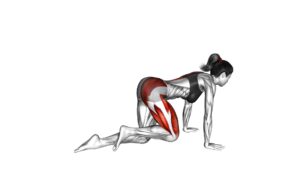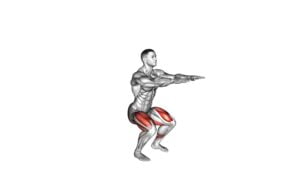Kneeling Single Slow Kickback (female) – Video Exercise Guide & Tips

Get ready to tone and strengthen your glutes with the Kneeling Single Slow Kickback. This exercise is perfect for targeting those hard-to-reach muscles, giving you a sculpted and firm behind.
Watch This Exercise Video
In this video exercise guide, we'll show you the proper form and technique, as well as provide helpful tips to maximize your workout.
Grab your mat and let's get started!
Key Takeaways
- Targets hard-to-reach glute muscles
- Provides a sculpted and firm behind
- Improves glute strength and stability
- Increases balance and coordination
Benefits of Kneeling Single Slow Kickback
To maximize your results, perform the kneeling single slow kickback exercise with proper form and control. This exercise is incredibly effective in improving glute strength and increasing stability and balance. By targeting the glute muscles, you can achieve a more toned and sculpted appearance in your lower body.
The slow and controlled movement of the kickback allows for maximum muscle activation and engagement. As you extend your leg back, you'll feel a deep contraction in your glute muscles, which will lead to improved strength over time.
Additionally, this exercise requires balance and stability, as you're kneeling on one knee while performing the movement. This helps to strengthen the supporting muscles around your glutes, leading to increased stability and balance in your daily activities.
Incorporating the kneeling single slow kickback into your workout routine won't only enhance the appearance of your glutes but also improve your overall lower body strength and stability.
Proper Form and Technique
Maintain a stable and controlled position throughout the kneeling single slow kickback exercise. This exercise is highly effective in targeting the glutes and hamstrings, but it's important to maintain proper form and technique to maximize its benefits.
One common mistake people make is allowing their back to arch or sag during the movement. To avoid this, engage your core and keep your spine neutral throughout the exercise. Another mistake is using momentum to lift the leg, rather than relying on the muscles. Make sure to use a slow and controlled movement, focusing on squeezing the glutes at the top of the kickback.
There are a few variations and alternatives you can try to switch up your routine. One variation is the kneeling single slow kickback with a resistance band. This adds extra resistance to the movement, intensifying the workout. Another alternative is the kneeling donkey kick, where you kick the leg straight back instead of at an angle. This targets the glutes from a different angle, providing a new challenge for your muscles.
Equipment Needed for the Exercise
You will need a resistance band for the kneeling single slow kickback exercise. This equipment is essential as it provides the necessary resistance to target and strengthen your glutes effectively. When choosing a resistance band, make sure it's the appropriate level of difficulty for your fitness level. Too much resistance can lead to improper form and potential injury, while too little resistance may not provide enough challenge for your muscles.
Common mistakes to avoid when using the resistance band include using too much momentum, which takes away from the targeted muscle engagement, and allowing the band to pull you forward or backward, compromising your balance and stability. To prevent these errors, focus on maintaining control throughout the movement and keeping your core engaged.
Variations of the kneeling single slow kickback exercise can be done using different types of resistance bands, such as loop bands or tube bands, to target the glutes from different angles. Additionally, you can progress the exercise by increasing the resistance or incorporating pulses at the top of the movement.
Now that you have a clear understanding of the equipment needed for the kneeling single slow kickback exercise, let's move on to the next section, where we'll discuss modifications and progressions to further challenge your glute muscles.
Modifications and Progressions
To challenge your glute muscles even further, consider incorporating variations and progressions into the kneeling single slow kickback exercise.
Progressions are a way to advance the difficulty of an exercise as you become stronger and more proficient. One progression you can try is increasing the resistance by using ankle weights or resistance bands. This will add more resistance to your glute muscles, making them work harder during the kickback movement.
Another variation is performing the exercise on an unstable surface, such as a BOSU ball or a foam pad. This will engage your core muscles even more as they work to stabilize your body while performing the kickback.
Additionally, you can try incorporating a pulse at the top of the movement. After extending your leg fully, hold it for a moment and then pulse it slightly higher before returning to the starting position. This will further activate your glutes and increase the burn in those muscles.
Remember to always listen to your body and progress at a pace that feels challenging but manageable.
Tips for Getting the Most Out of Your Workout
To maximize the effectiveness of your workout, focus on proper form and technique throughout the kneeling single slow kickback exercise. Here are some tips to help you get the most out of your workout and ensure that you're maximizing the intensity and efficiency of your time:
- Engage your core: Before you start the exercise, activate your core muscles by drawing your belly button towards your spine. This will help stabilize your body and protect your lower back.
- Squeeze your glutes: As you extend your leg back, focus on squeezing your glute muscles. This won't only target your glutes more effectively but also help improve your balance and stability.
- Keep your back straight: Maintain a neutral spine throughout the exercise. Avoid arching or rounding your back, as this can put unnecessary strain on your spine. Imagine a straight line from your head to your tailbone.
- Control the movement: Slowly extend your leg back and return to the starting position with control. Avoid swinging or using momentum to lift your leg, as this can reduce the effectiveness of the exercise.
Frequently Asked Questions
How Many Calories Can Be Burned by Doing the Kneeling Single Slow Kickback Exercise?
You can burn a significant amount of calories by doing the kneeling single slow kickback exercise.
This exercise targets your glutes and helps to tone them.
It requires you to kneel on all fours and then extend one leg back, squeezing your glutes as you do so.
The slow and controlled movement engages your muscles and increases calorie burn.
Incorporate this exercise into your routine for effective glute toning and calorie burning.
Can This Exercise Help in Toning and Shaping the Glutes?
Yes, this exercise can definitely help in toning and shaping your glutes. By performing the kneeling single slow kickback, you engage and activate your glute muscles, which leads to a more defined and sculpted appearance.
It's an effective exercise that targets the gluteus maximus, medius, and minimus.
However, if you're looking for alternative exercises, there are many other glute exercises that can also provide similar benefits, such as squats, lunges, and hip thrusts.
Are There Any Common Mistakes to Avoid While Performing the Kneeling Single Slow Kickback?
When doing the kneeling single slow kickback, it's important to be mindful of common mistakes that can hinder your progress.
Proper form is crucial to maximize the effectiveness of this exercise.
Some common mistakes to avoid include using momentum instead of engaging your glutes, arching your back, and not keeping your core stable.
Is It Necessary to Warm up Before Doing This Exercise?
Before performing any exercise, it's necessary to warm up. Warming up helps increase blood flow to your muscles, reducing the risk of injury and improving performance.
It prepares your body for the movements involved in the kneeling single slow kickback. If you're not comfortable with this exercise, there are alternatives such as standing kickbacks or using resistance bands.
Remember to listen to your body and choose the variation that suits you best.
How Often Should the Kneeling Single Slow Kickback Exercise Be Included in a Workout Routine for Optimal Results?
For optimal results, consider including the kneeling single slow kickback exercise in your workout routine.
It's important to find a frequency that works for you and your fitness goals.
This exercise targets your glutes and hamstrings, helping to strengthen and tone these muscles.
By incorporating the kneeling single slow kickback into your fitness plan, you can enhance your lower body strength and improve overall muscle definition.
Remember to consult with a fitness professional for personalized guidance.
Conclusion
Incorporating the kneeling single slow kickback into your workout routine can bring numerous benefits, such as targeting and toning your glutes and hamstrings.
By maintaining proper form and technique, using appropriate equipment, and making modifications or progressions as needed, you can maximize the effectiveness of this exercise.
Remember to focus on engaging the targeted muscles and listen to your body's limits.
With dedication and consistency, you can achieve great results from this challenging yet rewarding exercise.

Author
Years ago, the spark of my life’s passion ignited in my mind the moment I stepped into the local gym for the first time. The inaugural bead of perspiration, the initial endeavor, the very first surge of endorphins, and a sense of pride that washed over me post-workout marked the beginning of my deep-seated interest in strength sports, fitness, and sports nutrition. This very curiosity blossomed rapidly into a profound fascination, propelling me to earn a Master’s degree in Physical Education from the Academy of Physical Education in Krakow, followed by a Sports Manager diploma from the Jagiellonian University. My journey of growth led me to gain more specialized qualifications, such as being a certified personal trainer with a focus on sports dietetics, a lifeguard, and an instructor for wellness and corrective gymnastics. Theoretical knowledge paired seamlessly with practical experience, reinforcing my belief that the transformation of individuals under my guidance was also a reflection of my personal growth. This belief holds true even today. Each day, I strive to push the boundaries and explore new realms. These realms gently elevate me to greater heights. The unique combination of passion for my field and the continuous quest for growth fuels my drive to break new ground.







